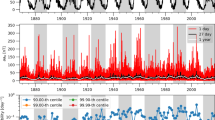Abstract
Short-term temperature variations on Earth (∼21 years) are analyzed along with long-term variations (tens of years). The global nature of short-term temperature variations indicates a possible relation between this phenomenon and the modulating effect of the Sun’s activity on cosmic rays. Mechanisms of long-term climate change on Earth (increased concentrations of carbon dioxide in the atmosphere and variation of the planet’s north magnetic pole) are discussed.
Similar content being viewed by others
References
Houghton, J., Rep. Progr. Phys., 2005, vol. 68, p. 1343.
Climate Change 2007: Synthesis Report, Pachauri, R.K. and Reisinger, A., Eds., Geneva: IPCC, 2007.
Boden, T.A., Marland, G., and Andres, R.J., Global, Regional, and National Fossil Fuel CO 2 Emission, Carbon Dioxide Information Analysis Center, Oak Ridge National Lab., 2013.
Timilsina, G.R., Atmospheric Stabilization of CO2 Emissions: Near-Term Reductions and Intensity-Based Targets, Washington: World Bank, 2007. https://openknowledge.worldbank.org/handle/10986/7300
Lawrimore, J.H., et al., J. Geophys. Res., 2011, vol. 116, p. D19121. doi: 10.1029/2011JD016187
WDC for Geomagnetism, Kyoto: Magnetic North, Geomagnetic and Magnetic Poles. http://wdc.kugi.kyoto-u.ac.jp/poles/polesexp.html
Afifi, A.A. and Azen, S.P., Statistical Analysis: a Computer Oriented Approach, New York: Acad. Press, 1979.
Bakhmutov, V., Quater. Int., 2006, vol. 149, p. 4. doi: 10.1016/j.quaint.2005.11.013
NOAA NWS Climate Prediction Center: Arctic Oscillation. http://www.cpc.ncep.noaa.gov/products/precip/CWlink/daily_ao_index/ao.shtml
Nordhaus, W.D., J. Econ. Lit., 2007, vol. 45, p. 686.
Author information
Authors and Affiliations
Corresponding author
Additional information
Original Russian Text © S.S. Vasiliev, V.A. Dergachev, 2015, published in Izvestiya Rossiiskoi Akademii Nauk. Seriya Fizicheskaya, 2015, Vol. 79, No. 5, pp. 727–729.
About this article
Cite this article
Vasiliev, S.S., Dergachev, V.A. Migration of the Earth’s north magnetic pole, increases in the concentration of CO2, and climate change in the twentieth century. Bull. Russ. Acad. Sci. Phys. 79, 673–675 (2015). https://doi.org/10.3103/S106287381505041X
Published:
Issue Date:
DOI: https://doi.org/10.3103/S106287381505041X




